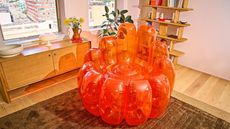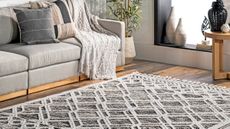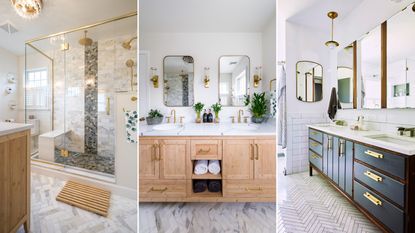Interior Design
The latest Interior Design breaking news, comment, reviews and features from the experts at Realhomes
Explore Interior Design
-

36 gorgeous kitchen island ideas that you and your guests will love
Looking for kitchen island ideas that will make your space both beautiful and functional? We've asked the pros for their favorite tricks, tips, and advice
By Eve Smallman Last updated
-

How to maximize space in a small bathroom — 7 pro tips that may surprise you
Want to know how to maximize space in a small bathroom? We've spoken with design pros to find out what to do, as well as picking out handy buys
By Eve Smallman Last updated
-

Jennifer Garner's dining room is filled with “cohesive and intentional” features that showcase her personality
Designers love how the actor's space is rustic yet refined
By Eve Smallman Published
-

Vanessa Hudgens’ wallpaper puts a trendy twist on a classic style — designers love her effortless approach
The actor's nature-inspired print is characterful and chic
By Eve Smallman Published
-

RuPaul's dining room is filled with colorful and conversation touches that bring “all the fun vibes”
Designers love the star's gorgeous and glamorous decorations
By Eve Smallman Published
-

I'm calling it — Beetlejuicecore is 2024's hottest Halloween trend
This playful style is perfect for getting into the spooky spirit
By Eve Smallman Published
-

Looking for table decorations for fall? These 9 editor-backed options are beautiful choices
Bring the season into your dining room with these pretty picks
By Eve Smallman Published
-

JELL-O furniture has officially landed — here's everything you need to know
The Jelly Collection is perfect for bringing dopamine decor into your home
By Eve Smallman Published
-

Ed Westwick's and Amy Jackson's home renovation is “a masterclass in blending countryside charm with sustainable luxury”
Designers love the warm yet inviting color and material choices
By Eve Smallman Published
-

I've seen the frazzled English woman trend everywhere — designers agree that it’s the perfect style for fall
Bring European seasonal style into your home with this rom-com inspired trend
By Eve Smallman Published
-

Colors to decorate with in fall — 5 gorgeous shades designers love
Try bringing these chic seasonal colors into your home this season
By Eve Smallman Published
-

Vintage nostalgia trend — why designers say this comforting style will last in 2024 and beyond
Interior pros have seen people reaching for the past in their homes this year
By Eve Smallman Published
-

The 5 fall decor trends interior designers say to try this season
Go for all the cozy vibes with these sweet styles designers love
By Eve Smallman Published
-

Pistachio green is everywhere this summer — this color is dreamy and delicious
Bring playfulness into your space with this versatile shade
By Eve Smallman Published
-

10 gorgeous bathroom backsplash ideas for every style space
From metro tiles to marble, sealed wallpaper to colorful designs, our bathroom backsplash ideas will help you choose the right addition to your room
By Sophie Warren-Smith Published
-

The 5 coffee table trends design experts are seeing everywhere in 2024
Looking to switch up your coffee table this year? We've asked design pros for the best trends to try this year, from fun styles to chic materials
By Eve Smallman Published
-

What kitchen floor colors make a small space look bigger? Interior pros spill their secrets
Want to know the kitchen floor colors that will make a small space look bigger? Design experts spill on the shades that will brighten your place up
By Eve Smallman Published
-

7 retro home decor ideas that will help you bring in this nostalgic trend
Bringing in retro home design will make your space look warm and inviting. Design pros spill on their favorite ways to bring this aesthetic in
By Eve Smallman Published
-

Sculpted and statement chairs can transform rooms in an instant. I'm a homes editor and here are my top picks
Editor's picks of gorgeous statement chairs to add a touch of style to your home
By Punteha van Terheyden Published
-

Amazon furniture deals — my top Editor's Picks on bedroom, bathroom, and living room finds
I'm Real Homes' editor and have spent hours looking for the retailers best offers that bring function and small-space style on budget-friendly prices
By Punteha van Terheyden Last updated
-

I've seen butter yellow everywhere this year — and interior designers agree it's 2024's hottest color trend
We've seen butter yellow interiors spread everywhere this season, and we're in love. Designers explain how to design with them and we pick out matching buys
By Eve Smallman Published
-

The best Walmart furniture to shop, filtered by room
These best Walmart furniture pieces are highly rated by shoppers, thanks to their style, easy assembly, and longevity. We've picked out buys for every room.
By Eve Smallman Last updated
-

Ashley Tisdale's tips for styling a credenza are right on trend for 2024 say design experts
Check out Ashley Tisdale's tips for styling a credenza. We asked interior design experts for their input on this trendy decor style
By Emily Lambe Published
-

9 of the best Amazon rugs — highly rated and designer picks from $14.99
These are the best Amazon rugs that are perfect for transforming your space. Pick up a budget-friendly find to add interest and insulation to a room
By Emily Lambe Last updated
-

Marble checkerboard flooring — why designers say this “anti-Kardashian” style is back on trend
Marble checkerboard flooring is back on trend, with designers loving using it right now. They share why it's a great choice and how to style it on a budget
By Eve Smallman Published
-

Interior pros love Lily Allen’s design tip for nailing cohesive living room color
Want to know Lily Allen’s design tip for creating cohesive color in a space? We've explained why it's such a good idea, plus picked colorful rug buys
By Eve Smallman Published
-

The 5 lighting trends that designers say will shine brightly in 2025
Looking for lighting trends to start following ahead of 2025? We've asked interior designers for the twinkling styles they predict will be big
By Eve Smallman Published
-

Art Deco style is trending — here's why designers say it will dominate interiors in 2025
Love Art Deco style as much as we do? You'll be pleased to hear it's trending. Here's why designers are using it, how to style it, plus top-rated picks
By Eve Smallman Published
-

How to microcement over tiles — 5 simple steps for a smooth finish
Want to learn how to microcement over tiles? We've asked interior designers for the key steps they always follow, plus curated highly-rated essentials
By Eve Smallman Published
